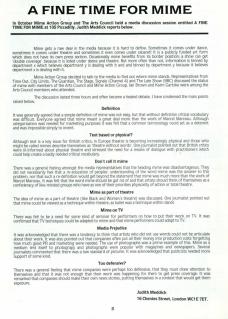Mime gets a raw deal in the media because it is hard to define. Sometimes it comes under dance, sometimes it comes under theatre, and sometimes it even comes under cabaret! It is a publicly funded artform which does not have its own press section. Occasionally mime benefits from its border position: a show can get ‘double’ coverage because it is listed under dance and theatre. But more often than not, information is binned by department X which believes department Y is dealing with it and and binned by department Y because it believes department X is dealing with it.
Mime Action Group decided to talk to the media to find out where mime stands. Representatives from Time Out, City Limits, The Guardian, The Stage, Signals (Channel 4), and The Late Show (BBC) discussed the status of mime with members of the Arts Council and Mime Action Group. Ian Brown and Karin Gartzke were among the Arts Council members who attended.
The discussion lasted three hours and often became a heated debate. I have condensed the main points raised below.
Definition
It was generally agreed that a simple definition of mime was not easy, but that without a definition critical vocabulary was difficult. Everyone agreed that mime meant a great deal more than the work of Marcel Marceau. Although categorisation was needed for marketing purposes it was felt that a common terminology could act as a deterrent and was impossible simply to invent.
Text based or physical?
Although text is a key issue for British critics, in Europe theatre is becoming increasingly physical and those who might be called mimes describe themselves as ‘theatre without words’. One journalist pointed out that British critics were ill-informed about physical theatre and stressed the need for a means of dialogue with practitioners which could help create a badly needed critical vocabulary.
Don’t call it mime
There was a general feeling amongst the media representatives that the heading mime was disadvantageous. They did not necessarily feel that a re-education of people’s understanding of the word mime was the answer to this problem, nor that such a redefinition would get beyond the statement that mime was much more than the work of Marcel Marceau. It was felt that the word mime should be got rid of and that artists should think of themselves as a confederacy of like-minded groups who have as one of their priorities physicality of action or total theatre.
Mime as part of theatre
The idea of mime as a part of theatre (like Black and Women’s theatre) was discussed. One journalist pointed out that mime could be viewed as a technique within theatre, as ballet was a technique within dance
Mime on TV
There was felt to be a need for some kind of seminar for performers on how to put their work on TV. It was confirmed that TV techniques could be adapted to mime and that mime performers could adapt to TV.
Media Prejudice
It was acknowledged that there was a tendency to think that artists who did not use words could not be articulate about their work. It was also pointed out that companies often put all their money into production costs forgetting how much good PR and marketing were needed. The use of photographs was a prime example of this. Mime as a medium lent itself to photography, and photographs were popular with magazines and newspapers. Several journalists commented that there was a low standard of pictures. It was acknowledged that publicists needed more support of some kind.
Too defensive?
There was a general feeling that mime companies were perhaps too defensive, that they must draw attention to themselves and that it was not enough that their work was happening for them to get press coverage. It was remarked that companies should make their own news stories, putting themselves in a context that would get them exposure.

